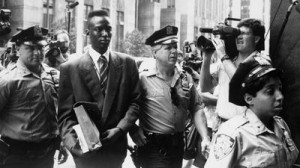
06 Sep AFTER TFF #39: INSIDER SPEAKS ABOUT “CENTRAL PARK FIVE”
Editor’s note: Thanks to the directors of the Telluride Film Festival, who never pull their punches, many of us were privileged, maddened and saddened to learn the story about the wrongful arrest and imprisonment of five black and brown teenage boys accused of assaulting and raping a young, white investment banker out for a jog in New York’s Central Park. Setting the record straight became the mission of the daughter of iconic documentary filmmaker Ken Burns. Sarah Burns wrote a book about the case, then directed the movie with her dad and husband David McMahon, which screened in town over Labor Day weekend. The investigation, trial and aftermath of the event describe a tragic story of compromised justice and persistent racism set in New York in 1989, a time when the city was losing its battle against crime. Part-time Telluride local Ilene Barth was there. Ilene, now a co-owner (with husband Richard Barth) of Red Rock Press, was one of the journalists who covered the story, yet she experienced the doc as a gut punch. Why? We are honored to publish her story. Read on and weep.
Last week’s screening of “The Central Park Five” hit me where I’d lived and worked.
The night in 1989 that a slight woman was bludgeoned, raped and left to bleed to death just yards from the jogging loop around the Central Park reservoir, I was sleeping in my bedroom looking onto the western edge of the park. My apartment was in the 20th precinct, a walk of less than five minutes to the station where police duped five man-children (ages 14-16) into falsely confessing to assault and rape.
I was a columnist and editor for New York Newsday where I wrote at least once about the trial of the five. I was there the day the woman known as “the Central Park jogger” testified. It had been a surprise appearance, missed by the great (now gone) writer Murray Kempton whose columns I edited and by my colleague Jim Dwyer, who is the media “talking head” in the documentary.
I knew, or had at least seen, almost everyone in the documentary: the testifying police officers, the press covering trial, the five defendants, Mayor Ed Koch, prosecutor Linda Fairstein who I then admired for considering rape an actual crime (not a reflection of the victim’s character or an unintended wardrobe consequence).
Like many New Yorkers, the crime had stunned me, shocked me out of skepticism at how quickly the police solved it. I, who was lucky enough to have a voice in the big city, had used it against the white subway shooter Goetz, and for the rights of the city’s voiceless black and Hispanic youngsters. But when it came to this “story” I had nothing important to say.
My own reporting had shown me that the police were wrong in some details; for instance, I discoverd that no way was “wilding” a teenage street term. But somehow I, like so many others, forgot to ask about semen-matches or to scrutinize the improbable time/place line the police had constructed to implicate five boys who’d been in the park in the early evening but not together.
I’m ashamed.
A decade ago, the boys convictions were vacated after a different prisoner, convicted a different murder-rape, admitted his guilt and his semen was found to match that which had been found in the jogger as she lay struggling for life in the hospital. The police had the guilty party’s semen sample before the trial of the five boys even began, but did not botter to compare it to the sample taken from the brutalized jogger. (Police and prosecutors knew that there was no DNA match between that sample and the boys on trial for assaulting her.)
The year the defendants were shown innocent was my cancer year. I wasn’t paying attention to much outside that and my family. When I went out into the daylight after the movie I was in tears. The five defendants’ boyhoods had been yanked from them, turned to prison terms and ashes. And the city has yet to settle a civil suit on their behalf.
Via Facebook, I reached out to Jim Dwyer with whom I’d lost touch after we both left Newsday and he’d joined The New York Times. He indicated that he regarded the under-reporting of the innocence of the Central Park Five more scandalous than our initial coverage.
We, the press, were accurate then. We told you exactly what the police said and what was later shown and heard in the courtroom. “Accurate” reporting and truth are not the same thing.
I learned much sitting in the dark in Telluride watching “The Central Park Five.”
My cancer is long gone; my sunny days of journalistic scoops are over. My children are grown. The only injury any of us ever suffered in Central Park was when Daisy, then five, suffered a broken collarbone after colliding with an empty moving swing.
Something much heavier crashed in the Central Park Five. I didn’t see it coming and I didn’t realize its meaning or understand its impact until now.



Sorry, the comment form is closed at this time.